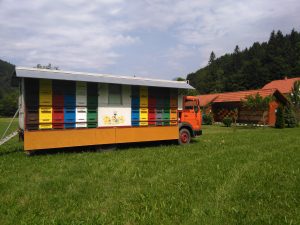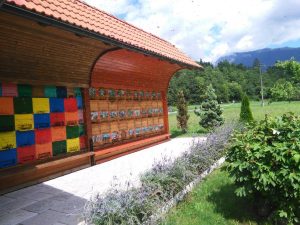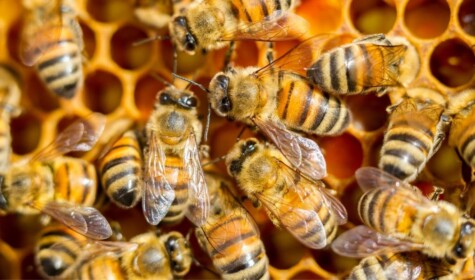Bees may be small, but don’t underestimate their importance. Of the 100 crop species which provide approximately 90% of food worldwide, 71 are dependent on pollination by bees, of which there are a variety of species. Although pinpointing their financial value to agriculture is tricky, it has been estimated that the pollination of crops by bees is worth between $37 and $91 billion annually. Consider that next time you eat, well, almost anything.
The Bees-knees
Unlike many wild pollinators, including bumblebees, moths and butterflies, honeybees normally live in hives managed by beekeepers. As important as they are in the pollination of foods such as apples, almonds, coffee and squash, honeybees also play a significant role in the pollination of other crops such as cotton and flax – not to mention the significance of honey, the product of all their hard work.

Hexagonal cells of honeycomb
Many of us take honey for granted. In fact, the process of making it is quite complex. When bees have a full load of nectar, they return to the hive where they pass it on through their mouths from bee to bee until it gradually softens and turns into honey. The bees then store it in perfectly formed hexagonal cells made of honeycomb, a process at the heart of a long-standing debate about whether this is “exquisite biological engineering or blind physics”. The cells act like tiny jars, holding the honey while the bees fan it with their wings until it is dry and sticky; the bees then seal the cell with a wax lid to keep the honey clean. To put this astonishing activity into perspective, one teaspoon of honey takes at least eight bees their entire lifetime to produce.
A hive of activity
Beekeepers are diverse in their approach to beekeeping. Commercial beekeepers, dependent on honey production for their livelihoods, manage their bees much like conventional livestock, pushing honey production to the limit. In response to an increasingly limited variety of flowering plants, resulting in part from monoculture cropping and the intensification of agriculture more generally, many beekeepers replace the harvested honey (a bee’s natural source of food) with a sugar substitute that lacks essential micronutrients and protein.
Migratory beekeeping, a practice in which farmers transport thousands of hives, sometimes hundreds of miles, to fields where bees live for a short time to pollinate specific crops, is common in industrial agriculture. For example, in California’s Central Valley, every February, 31 billion honeybees converge to pollinate almond trees. Aside from the issue of exploitation, “forcing bees to gather pollen and nectar from vast swaths of a single crop deprives them of the far more diverse and nourishing diet provided in the wild”. Boomeranged between times of plenty and times of near starvation, the bees often have little to eat once a particular bloom is over. Such food scarcity has been shown to have a significant effect on oxidative stress levels in honeybees, not to mention that the high concentration of multiple colonies in one small area spreads disease and increases the likeliness of colony collapse disorder – impacted also by the prevalence of parasites, agrochemicals and poor nutrition. These weaken the honeybees’ immune system, making them more susceptible to deadly viruses and infections. But many beekeepers now make more money from renting their hives than they do from their honey.
In stark contrast, some beekeepers have engaged in a process of ‘rewilding’ – a conservation strategy which involves harvesting little to no honey from the colonies and instead lets them exist in naturally occurring, unmanaged ecosystems. This type of beekeeping represents the extreme, however there are many small-scale honey producers across the world that respect bees’ natural living conditions, encouraging the sowing of wildflowers to offer a balanced diet and leaving enough honey in the hive to sustain the bees themselves. The biodynamic approach is one such example of this more natural form of beekeeping.
An ecological Armageddon
In 2016, there were warnings of an ecological Armageddon, after a German study found that three-quarters of flying insects in nature reserves across the country had vanished in the past 25 years. Until recently, concerns about the effect of agrochemicals on bees, have focused on the impact of neonicotinoid pesticides impairing their ability to navigate and forage, damaging their memory and reducing the number of queens. A major report by the EU’s scientific risk assessors concluded that the use of pesticides, including clothianidin, imidacloprid and thiamethoxam, which contaminate both soil and water, is also of high risk to bees (not to mention a study which revealed that not only do bees enjoy consuming certain pesticides, they experience something comparable to addiction when they do). Further research into pollinator health has revealed that glyphosate, one of the world’s most controversial agrochemicals, may also be contributing to a global decline in bees, along with the loss of their habitat.
In 2018, the UK voted in favour of a total ban on the use of neonicotinoid pesticides, outside of greenhouses, to come into force by the end of the year (although loopholes mean their use is continued even today). Defra also launched a £60,000 fund to develop and test pollinator habitat mapping, to help boost the number of pollinator-friendly landscapes as set out in the Government’s 25 Year Environment Plan. In 2018, we argued that ensuring environmental regulation was not watered down when Britain left the European Union would require convincing some farmers that it is possible to farm in harmony with nature and produce enough food, without the use of chemical pesticides. The National Farmers Union called the ban on neonicotinoids “regrettable” and “not justified”. Unfortunately, it seems that a watering down was exactly where we found ourselves, as an exception was made for the 2021 and 2022 sugar beet crop.

Tomaž Kokl’s ‘bee hut’, home to over 200 colonies of honeybee
Safety in the EU?
Perhaps the UK should look towards other European countries such as France – the first country in Europe to ban all five neonicotinoid pesticides linked to the decline in insect populations – or Slovenia, where 1 in 200 people keep bees. Incredibly, and in contrast to the decline in bee numbers worldwide, Slovenia has seen no major losses in recent years or any reported cases of colony collapse disorder. It doesn’t take a genius to attribute this, at least in part, to the fact that in 2011, Slovenia was the first European country to prohibit the use of certain neonicotinoids proven harmful to bees. The Bee Path Project encourages citizens in the capital city Ljubljana to plant nectar-bearing flowers and share seeds. Measures have also been taken to protect both bees and their keepers, including the banning of glyphosate in public areas, and the cutting of grass later in the year to prolong the blooming of flowers.

Tomaž Kokl’s traditional beehives in Slovenia
I recently visited Tomaž Kokl, a beekeeper in Slovenia whose passion for bees is as clear as his honey. Following in the footsteps of his parents, Tomaž takes care of over 200 hives, nestled within the unspoiled nature of the Storžič mountains. He began by purchasing a ‘bee truck’, containing 72 hives which he and his wife Anastazija “eagerly drove around Slovenia” in search of the best of nature’s own nectar. Ten years later, Tomaž’s passion for bees continues to grow. Despite “knowing bees” his whole life, Tomaž had “no idea that they would end up bringing [him] so much joy”. One of the pioneers of apitourism, Tomaž is now the proud holder of a national vocational qualification in beekeeping and regularly shares his knowledge with groups of tourists, school children and other beekeepers.
Tomaž told me that “beekeeping is a way of life” in Slovenia, and their approach to keeping bees is neither “industrial nor intensive”. Instead, bee populations thrive not only because of their promotion by Slovenia’s Beekeeping Association, but thanks to the “preservation of pure nature without the use of genetically modified plants” or chemicals.
Bee Happy
It is often cited (although not confirmed) that Albert Einstein once said, “If the bee disappeared off the surface of the globe, then man would only have four years of life left. No more bees, no more pollination, no more plants, no more animals and no more man.” It is now overwhelmingly agreed that without bees, the global food supply chain would be at significant risk. Yes, scientists are working on alternatives to bees for pollination, but relying on robotic bee-like drones to do the job seems a little too much like science fiction (or a terrifying episode of Black Mirror).
In any case, rather than focus on apocalypse-ready solutions, surely, we should be looking to disincentivise the use of agrochemicals, as part of a systemic shift towards more sustainable farming practice. As a result of the UK’s departure from the EU, we may have, in the words of Environment Secretary Michael Gove, an “unfrozen moment” – the opportunity to re-shape agricultural and environmental policy. Farmers should be rewarded for delivering measurable environmental goods for the benefit of numerous species including honeybees and other wild pollinators, as well as for human and environmental health.
Perhaps we should take inspiration from the bees themselves, who have been able to live and work sustainably on earth for over 100 million years. Not only are they able to work effectively on their own, but they thrive collectively in harmony with one another and with other species, focused on the wellbeing of the entire colony. To live in harmony with nature, we too must become stewards of natural capital, acknowledging and nurturing vitally important species like bees, the original stewards of the land.
Photos: Richard Dunne and Tomaž Kokl
This article was originally published in November 2018.



